Mandala art is bursting with creative possibilities—picture bold geometric patterns, swirling flower petals, fierce animal shapes, and sun and moon motifs lighting up black paper with metallic gel pens. Some mandalas twist vibrant colors into nature scenes, while others play with negative space or mix zany doodles, playful typography, even leaves or seashells. Team projects invite friends to create a mandala masterpiece together, turning art into a story. If curiosity’s sparked, there’s even more inspiration on the way.
Key Takeaways
- Experiment with geometric and minimalist mandalas using sharp lines, bold contrasts, and creative use of negative space for striking visual effects.
- Create nature-inspired mandalas featuring flowers, leaves, and botanical details to evoke calm and celebrate the beauty of the natural world.
- Incorporate animal forms or celestial motifs like suns and moons to add personality, symbolism, and narrative to your mandala designs.
- Explore watercolor and mixed media techniques, layering diverse materials and textures to produce unique, multidimensional mandalas.
- Infuse cultural symbols or encourage community collaboration, transforming mandalas into interactive pieces that tell stories and unite people.
Geometric Pattern Mandalas
Geometry fans, get ready—geometric pattern mandalas are like a math lover’s dream come to life. Imagine a burst of circles, squares, triangles, and even hexagons, all arranged perfectly around a center point. It’s symmetry heaven!
Every geometric design in these mandalas relies on repeating shapes, so the whole thing looks crazy balanced and super satisfying to stare at. Artists can play around by mixing up the size and direction of the shapes, making the design pop with layers and depth.
Whether they use pencils and rulers or a digital drawing tablet, creators have tons of control to keep those lines razor-sharp. Throw in some bold, contrasting colors, and the details practically jump off the page. It’s math, but make it art!
Nature-Inspired Flower Mandalas
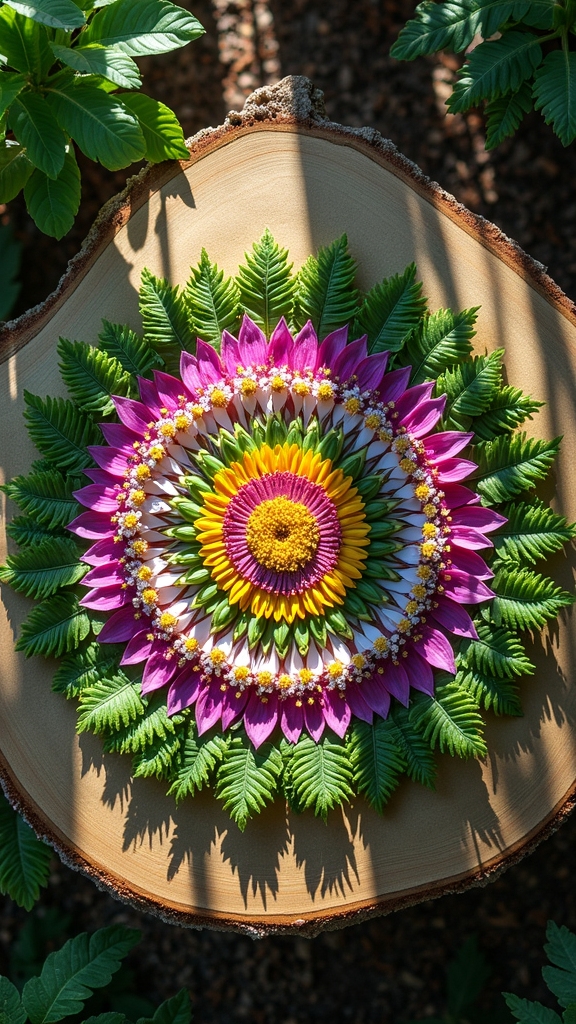
Flowers are basically nature’s mandalas, so it makes total sense that artists love using them as inspiration for their designs. Nature-inspired flower mandalas burst with vibrant colors and swirling mandala patterns, making each unique mandala feel alive.
With mandala art, artists often start with a central flower, then let petals, leaves, and stems radiate outward, just like real flowers growing in a garden. Some use colored pencils or markers, while others get creative and actually use real petals or leaves—how cool is that?
Adding intricate designs and tiny details can turn simple drawing ideas into beautiful mandalas that seem almost magical. Anyone can create your own mandalas, experimenting with color and shape, making every mandala design a fresh, new adventure in creativity.
Animal Form Mandalas
After exploring the beauty of flower-inspired mandalas, it’s only natural to wonder what happens when animals take center stage.
Enter the world of animal form mandalas, where creativity gets wild—literally! Artists combine detailed mandala patterns with the shapes of lions, owls, turtles, or even butterflies. Each animal brings its own vibe: a lion radiates strength, while a butterfly is all about grace and transformation.
Animal form mandalas are a playground for experimenting with textures and colors, making every design pop. Symmetry and balance keep things looking sharp, even when the patterns get complicated.
For many, it’s a chance to show off their love for nature and the animal kingdom. Every mandala tells a story—sometimes fierce, sometimes gentle, always fascinating.
Celestial Sun and Moon Mandalas
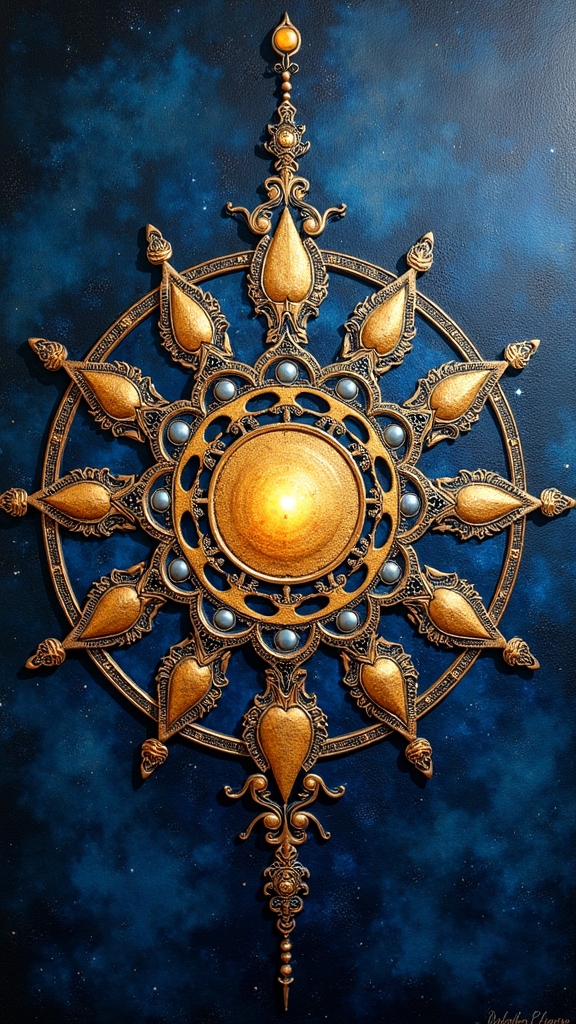
Celestial sun and moon mandalas are all about balancing light and shadow, kind of like a cosmic tug-of-war right on your sketchbook.
These designs use bold, swirling sunbursts mixed with gentle, dreamy moons to show how day and night work together, not against each other.
Balancing Light and Shadow
Even though the sun and moon seem like total opposites, putting them together in a mandala creates a super cool design that’s all about balance. In mandala artwork, artists love using the sun’s bold rays and the moon’s gentle crescent shapes to show how light and shadow can work together. Bright yellows and oranges for the sun mixed with cool blues and silvers for the moon totally make the design pop. Asymmetrical patterns keep things interesting and show that life isn’t always perfect circles—sometimes it’s wobbly, and that’s awesome! People have been inspired by ancient myths where the sun and moon are super important, too. Check out this table for creative ideas:
| Sun Element | Moon Element | Design Tip |
|---|---|---|
| Spiky Rays | Crescent Shape | Try bold color contrasts |
| Warm Colors | Cool Colors | Mix symmetry and asymmetry |
| Solar Motifs | Lunar Motifs | Blend ancient symbols |
| Dotted Patterns | Swirling Lines | Play with light and dark |
| Central Placement | Side Placement | Balance both energies |
Cosmic Symbolism in Mandalas
When it comes to mandalas, there’s something extra magical about adding sun and moon symbols—almost like bringing the universe right onto the page.
In mandala drawing, the sun isn’t just a ball of fire in the sky; it’s a symbol of energy and positivity, usually bursting with bright colors and bold, lively shapes that make you feel warm just looking at them.
The moon, on the other hand, brings a cool, calming vibe, with soft colors and smooth lines that seem to whisper “relax.”
Combining sun and moon in a mandala drawing creates a cosmic dance, showing the balance between light and dark.
It’s not just art—it’s a way to meditate, reflect, and feel connected to the universe.
Black Paper Metallic Mandalas
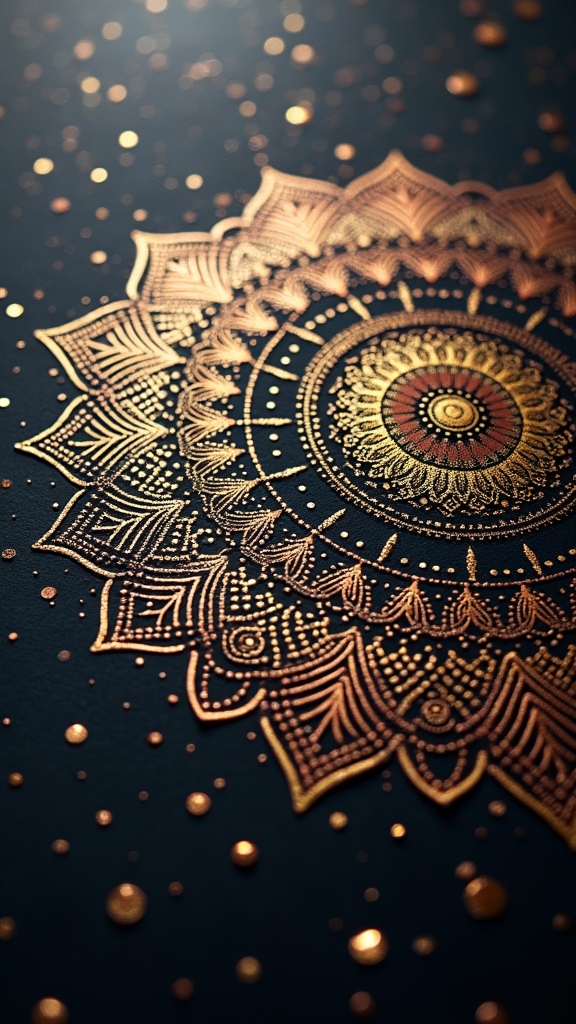
Black paper metallic mandalas are all about picking the right pens—think shiny metallics or glittery gel pens that really pop against the dark background.
The contrast is wild; colors look brighter and lines seem to glow, making even simple patterns look extra fancy.
Whether someone wants to try bold geometric shapes or swirling vines, this style opens up tons of cool pattern ideas that just beg for creativity (and maybe a little bit of sparkle).
Choosing the Right Materials
Although picking out supplies for mandala art can seem tricky, using black paper with metallic pens is like revealing a secret level of awesomeness. Mandala means circle, and when those shiny metallic lines hit the deep, dark paper, it’s like magic. The black background makes every color sparkle, turning even the simplest designs into something totally eye-catching. Metallic gel pens or markers work the best, especially for tiny details and fancy highlights. Layering these inks can create cool shadows and glowing effects. Even basic patterns look stunning, thanks to the bold contrast. Here’s a look at how the right materials can change everything:
| Feeling | Why It Matters |
|---|---|
| Excitement | Shiny colors pop on black |
| Pride | Simple designs look advanced |
| Curiosity | New color combos await |
| Joy | Every detail stands out |
| Confidence | Materials make success easier |
Enhancing Contrast With Color
There’s something seriously awesome about how metallic colors explode off black paper, almost like they’re glowing with secret energy.
When creating mandalas, artists quickly discover a variety of ways to make their Art stand out by drawing on black paper using metallic or gel pens. This combo isn’t just eye-catching—it’s sure to spark new Art Ideas and add complexity to any design.
Whether you start with basic shapes around the center or go for a wild, intricate mandala, the contrast is unbeatable. Gold, silver, or even neon shades pop like fireworks, making your Art look anything but black and white.
Plus, these designs are all over social media, so if you want the right place to show off, you’re definitely on trend!
Creative Pattern Inspirations
Even the most classic mandala patterns can get a massive upgrade when metallic pens and black paper join the party. Suddenly, every line, dot, and swirl leaps off the page like it’s trying to grab your attention.
Metallic inks reflect the light, so your mandala changes its look depending on where you show it off—kind of like a secret superhero with a shiny cape! The deep black paper makes every metallic color pop, pushing artists to try bold new color combos and patterns.
There’s a whole world of creative pattern inspirations just waiting to happen. Artists can mix and match metallics—gold, silver, neon blue, or even wild pink—for unique mandala designs that look totally fresh.
Talk about imagination set free!
Abstract Watercolor Mandalas
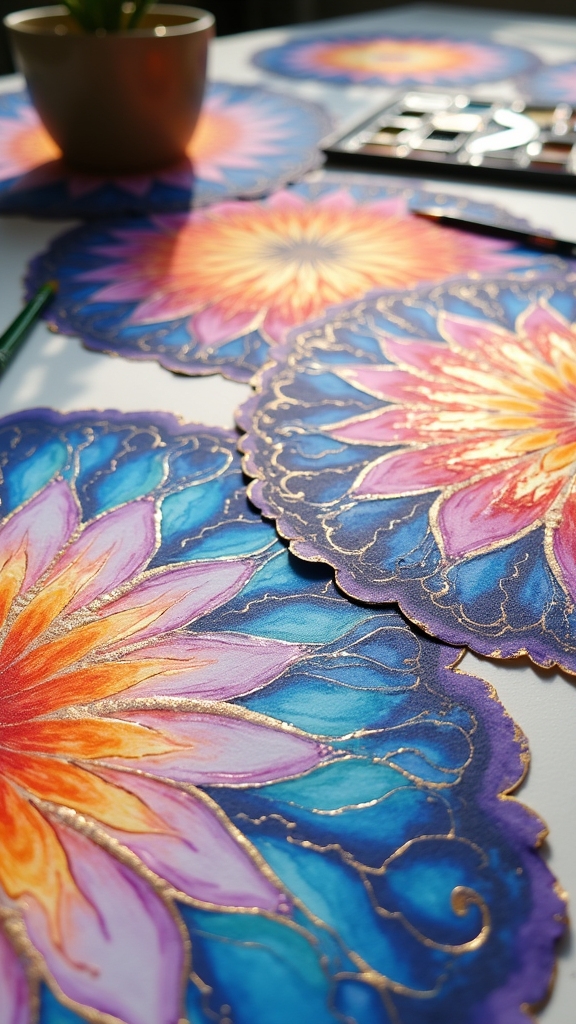
Color bursts onto the page with abstract watercolor mandalas, turning a simple circle into a wild playground for the imagination. With Fluid Exploration as the guiding spirit, artists let go of symmetry and perfection, splashing colors and shapes wherever inspiration strikes. Watercolor’s magic—its ability to blend, drip, and layer—creates soft edges and surprising color mixes. Wet-on-wet swirls into dreamy shifts, while wet-on-dry pops with boldness. There’s no pressure to make it “just right”—it’s about freedom, fun, and a little bit of happy chaos. The process becomes a meditative escape, letting worries melt away with each brushstroke. Abstract designs remind everyone: art isn’t always about rules. Sometimes, it’s about letting go.
| Emotion | Watercolor Effect |
|---|---|
| Joy | Vibrant color pools |
| Calm | Gentle blending |
| Wonder | Unexpected mixes |
| Freedom | Loose forms |
| Relaxation | Soft shifts |
Minimalist Line Mandalas
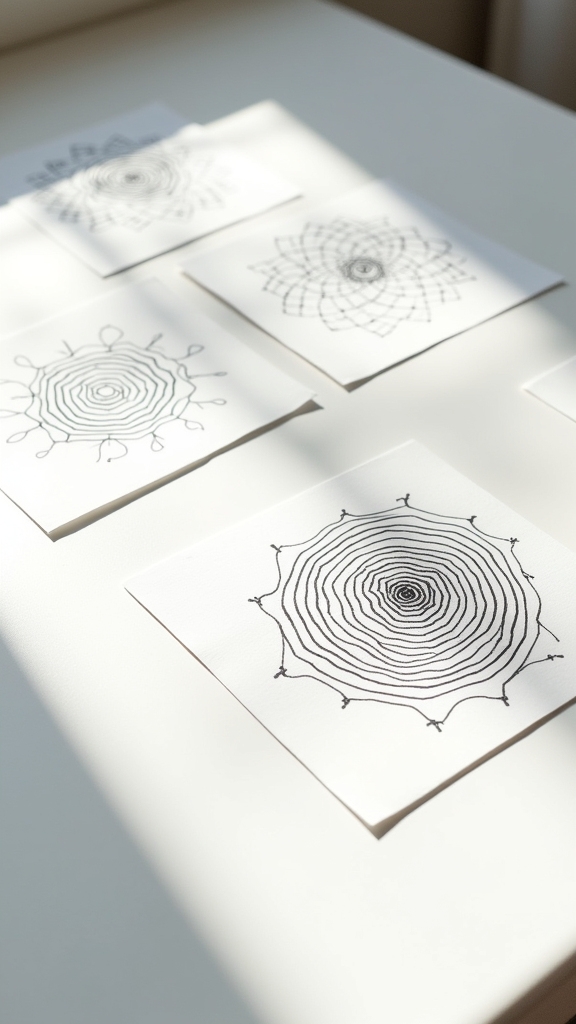
Minimalist line mandalas really shine when artists play with negative space, letting blank areas do some of the talking and making the designs feel fresh and modern.
Using just one color—yep, monochrome style—keeps things simple, but it also puts all the focus on the cool patterns and shapes.
It’s kind of like magic: a few well-placed lines, some empty space, and suddenly you’ve got a mandala that looks both calm and super stylish, no fancy art degree required.
Embracing Negative Space
Ever wonder how something so simple can look so powerful? That’s the magic of embracing negative space in minimalist line mandalas. Instead of filling every inch with details, artists use clean lines and large empty spaces, letting the absence of stuff actually become the star.
It’s like the quiet in a song making the music feel even louder! When artists use contrasting colors—think bold black ink on bright white paper—the negative space pops, making the whole design look sharp and balanced.
Here’s why negative space works so well:
- It highlights the beauty of simplicity and calm.
- It makes shapes and patterns stand out more.
- It lets beginners and pros create stunning art without stress.
Sometimes, less really is more!
Monochrome Mandala Techniques
Step into the world of monochrome mandalas, and it’s like discovering a secret code hidden in black and white. These mandalas look simple, but they’re anything but boring. Using just one color—usually bold black ink—they create striking patterns with thin and thick lines, almost like magic tricks for your eyes.
Minimalist line mandalas are perfect for Mandalas Meditation, because your mind isn’t distracted by color and can focus on the calm rhythm of drawing. Plus, creating these designs builds awesome control and precision, which is basically like leveling up your art skills.
Anyone can start—no experience required—just grab a fine-tip pen and let your imagination go wild. The best part? Even the mess-ups can look cool in monochrome!
Mandalas With Embedded Landscapes

Sometimes, mandalas can be more than just cool patterns—they can actually hold tiny worlds inside them! Mandalas with embedded environments use Environment Fusion to blend swirling lines and shapes with scenes like mountains, forests, or wild oceans.
It’s like zooming into a snow globe, but way more detailed and magical. Artists love to mix geometric shapes with natural scenes, giving each mandala a secret story. Color gradients and shading bring these environments to life, making every section pop without breaking the mandala’s symmetry.
Here’s what makes these designs seriously awesome:
- They combine calm natural scenes with bold patterns for a unique vibe.
- The seamless shift between shapes and environments sparks creativity.
- Focusing on peaceful scenery can help artists feel more mindful and chill.
Mandala Collages With Mixed Media

Plunge into a world where mandalas aren’t just drawn—they’re built, layered, and even sprinkled with a bit of magic from everyday stuff. Mixed media mandala collages combine classic patterns with all kinds of materials, from fabric scraps to seashells or even sand. The result? Textured layers that pop off the page, making each piece totally one-of-a-kind. Digital tools like Procreate let creators play with layers before gluing anything down, making mistakes easy to fix (phew!). Adding photos of leaves or flowers gives a personal twist, while experimenting with colors and layering techniques leads to mind-blowing art. Check out these ideas:
| Material Used | Possible Effects |
|---|---|
| Fabric pieces | Soft, colorful texture |
| Seashells | Natural, tactile feel |
| Sand | Grainy, 3D surface |
| Photographs | Personal, unique vibe |
Mandalas Using Recycled Materials
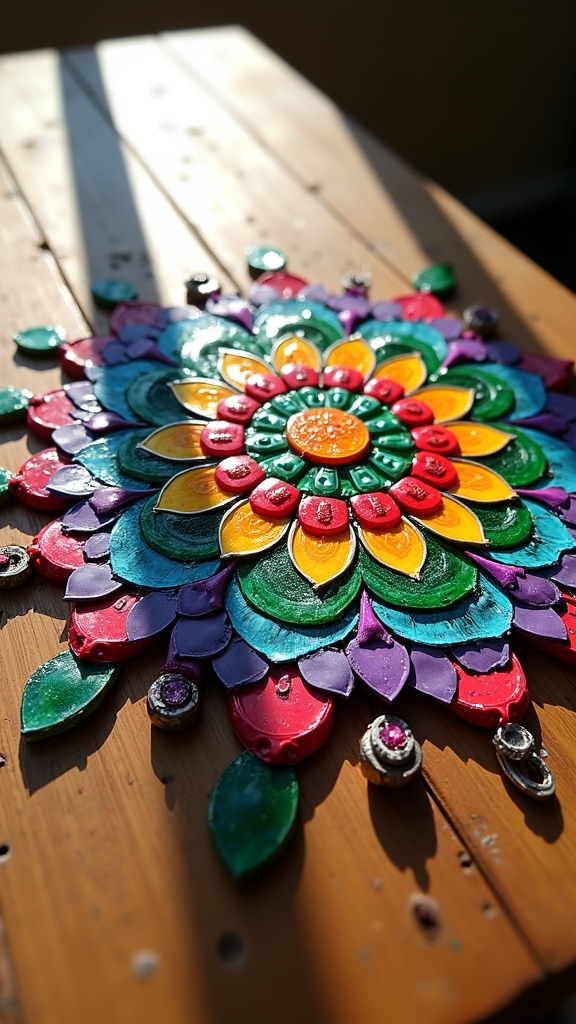
A pile of old magazines, a handful of bottle caps, and some random scraps of paper—who knew trash could be the start of something so awesome?
Creating mandalas with recycled materials isn’t just crafty, it’s a cool way to give new life to stuff that normally gets tossed. These mandalas come alive with Recycled Textures, from bumpy bottle caps to soft fabric scraps, and every piece tells a story.
Sometimes artists even add things like leaves or twigs for a natural vibe, making each mandala totally unique. It’s not just about art—it’s about making a difference, too.
Here’s why it matters:
- Reduces waste and helps the planet
- Sparks creativity using unexpected stuff
- Shows the hidden beauty in everyday trash
Monochrome Contrast Mandalas
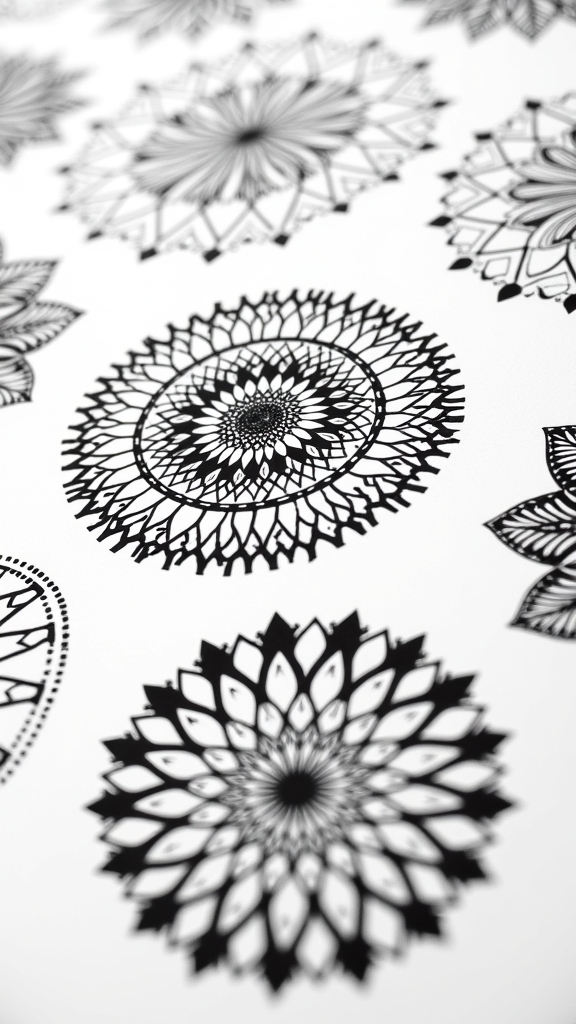
Monochrome contrast mandalas are all about that bold black and white harmony—think of it like a cool graphic novel, but for art lovers.
Artists use shading and line tricks to give these designs real depth, making simple shapes pop right off the page.
With just a single pen or pencil, anyone can experiment with minimalist lines and patterns, so even beginners can create something that looks seriously impressive (and maybe even a bit mysterious).
Black and White Harmony
Ever wondered how something as simple as black and white can look so dramatic?
Black and white harmony in mandalas is like Monochrome Meditation for the eyes and mind—it’s all about balance, contrast, and pure focus. No color means no distractions, just the bold dance between light and dark.
These mandalas can be super detailed or totally minimalist, but both styles invite you to stare and get lost in the patterns. There’s a quiet power to these designs, almost like they’re whispering secrets through the symmetry.
Check out how black and white mandalas spark imagination:
- Contrast highlights every line and shape, making them pop.
- Negative space creates calm, peaceful vibes.
- Simple tools—just pens and paper—let creativity shine.
Depth Through Shading
Shading isn’t just for comic books or art class doodles—within mandala design, it’s like magic that turns flat patterns into eye-popping, almost 3D creations.
With monochrome contrast mandalas, artists use different shades of just one color to make patterns leap off the page. Shading Techniques like cross-hatching and stippling add depth, making each layer look like it’s popping out or sinking in.
Imagine using a fine-tip black pen for crazy-detailed lines, then switching to a chunky marker for bold, shadowy areas—boom, instant drama!
Planning is key: most mandalas start with a strong center and spiral outward, letting you play with light and shadow as you go.
Experimenting with Shading Techniques isn’t just fun; it’s a chance to express yourself in totally new ways.
Minimalist Line Techniques
Some artists like to keep things simple but still want their mandalas to pack a serious punch, and that’s where minimalist line techniques come in.
These mandalas lean into line simplicity, using just black and white for maximum contrast. The secret? It’s all about crisp, elegant lines and balanced patterns. Fine-tip pens work wonders for getting those lines sharp and clean—no wobbly lines allowed!
Here’s what makes monochrome contrast mandalas so exciting:
- Clarity and Focus: No distractions—just pure, bold shapes that grab your attention.
- Balance and Harmony: Repetitive geometric forms create a peaceful, almost hypnotic vibe.
- Easy Entry for Beginners: Minimalist designs are a great place to start, encouraging creativity without feeling overwhelming.
Simple, but seriously stunning!
Mandala Art With Cultural Symbols
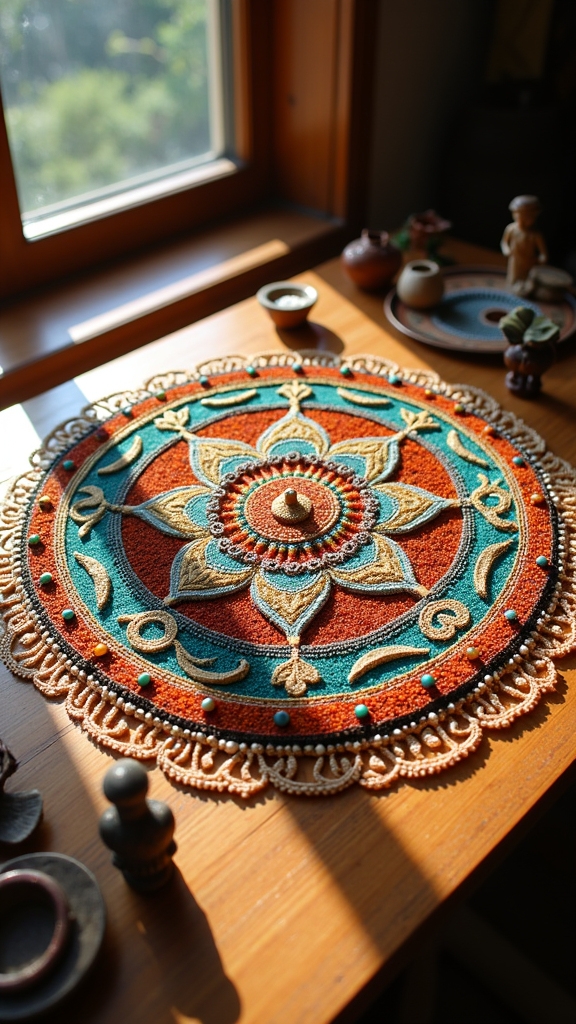
Although mandalas are known for their beautiful patterns, things really get interesting when they’re mixed with cultural symbols from around the world. Suddenly, each swirl or curve isn’t just for looks—it’s packed with Cultural Significance!
Take the lotus flower in Buddhist mandalas: it’s not just a pretty plant, it stands for purity and spiritual awakening. In Hindu traditions, mandalas called yantras might show gods and goddesses, linking the whole universe to the divine, all inside a neat square.
Native American mandalas use animal shapes and elements from nature, acting as spiritual guides. Celtic mandalas love their twisty knots and spirals, showing how life goes in circles—forever!
Even African mandalas pack in tribal colors and patterns, making art that celebrates unique heritage.
Mandalas on Everyday Objects
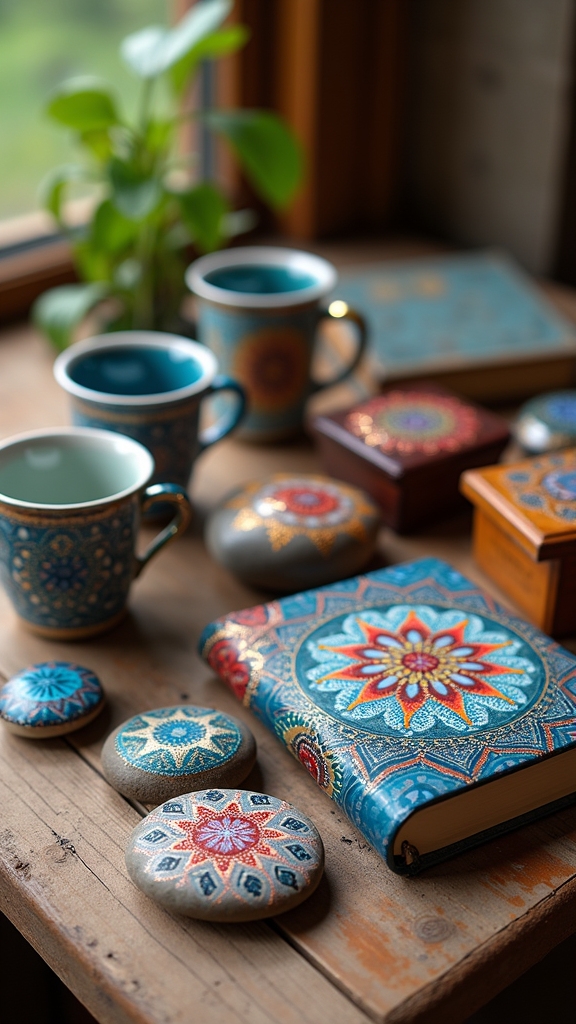
Mandalas aren’t just for paper or coloring books—they can turn plain old objects like mugs, tote bags, or even phone cases into eye-catching art.
Suddenly, a boring coaster or flower pot becomes something special, showing off someone’s creativity right where everyone can see it.
When everyday items become canvases for mandala designs, life gets a little more colorful—and maybe a bit more fun, too!
Transforming Objects With Mandalas
Even the most ordinary objects can turn into eye-catching masterpieces when covered in swirling mandala designs. Who knew a plain plant pot or a boring phone case could become a work of art?
Mandalas and mindfulness go hand in hand—adding these patterns to daily stuff brings creativity and calm into the routine. Some people even use seashells, glass, or fabric to create textured mandalas that pop out and make everyone look twice.
Imagine sipping from a coffee mug with a hand-drawn mandala; suddenly, mornings feel magical.
Here are three ways mandalas transform objects:
- Personalization: Everyday items like water bottles become one-of-a-kind treasures.
- Harmony: Home décor feels more balanced and peaceful.
- Experimentation: Digital tools let artists try wild colors and styles without the mess!
Everyday Items as Canvases
When someone grabs a plain old mug or a boring coaster, it’s easy to think it’ll always look the same—but that’s where a little mandala magic can totally flip the script.
Everyday items are perfect for transforming into functional art that not only looks cool but actually gets used. Imagine sipping hot cocoa from a cup covered in swirling mandala designs or setting your phone down on a case that’s basically a mini masterpiece.
Even flower pots and trays can turn into surprising bursts of color and pattern—suddenly watering plants feels like an art show!
Furniture isn’t off the table either (pun intended). Mandalas on tables or chairs become instant conversation starters, making any room feel more creative.
Why settle for plain when you can have art everywhere?
Digital Mandala Creations
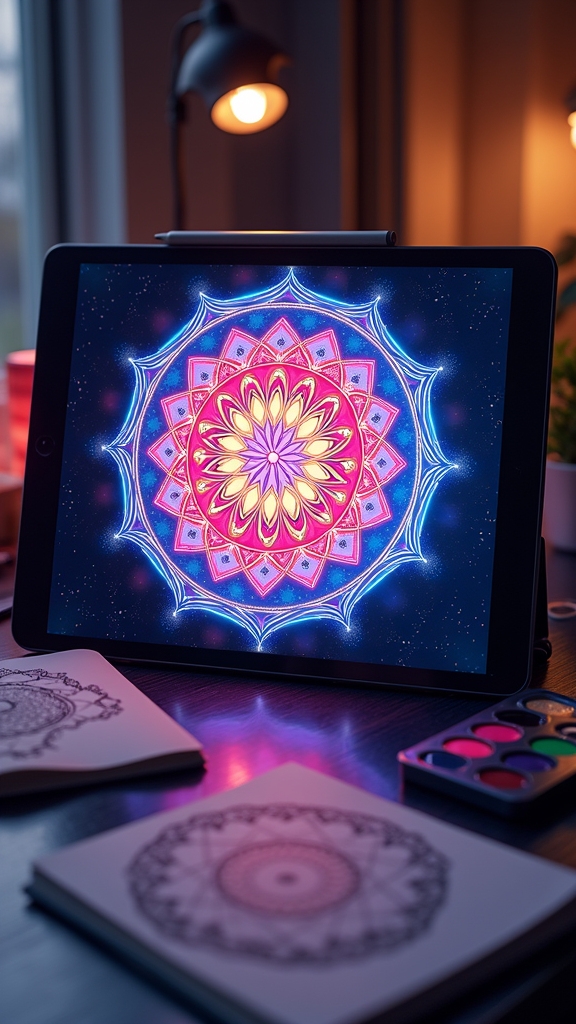
How do artists whip up such jaw-dropping mandala designs without ever touching a pencil? The answer lies in the world of digital mandala creations, where a Creative Workflow takes center stage.
With programs like Procreate, artists can easily tweak, erase, and perfect their designs—no eraser shavings required! Layers let them build up complex patterns, adding depth and dimension that might make your eyes pop. Plus, digital tools help artists copy and repeat shapes, making symmetry a breeze.
Here’s why digital mandalas totally rock:
- Quick edits—Mistakes? Just hit undo!
- Portable creativity—Design anywhere, from a park bench to your bedroom.
- Pattern precision—Achieve perfect symmetry with a simple tap.
Digital mandala art: it’s high-tech magic for creative minds!
Mandalas Featuring Bold Color Palettes
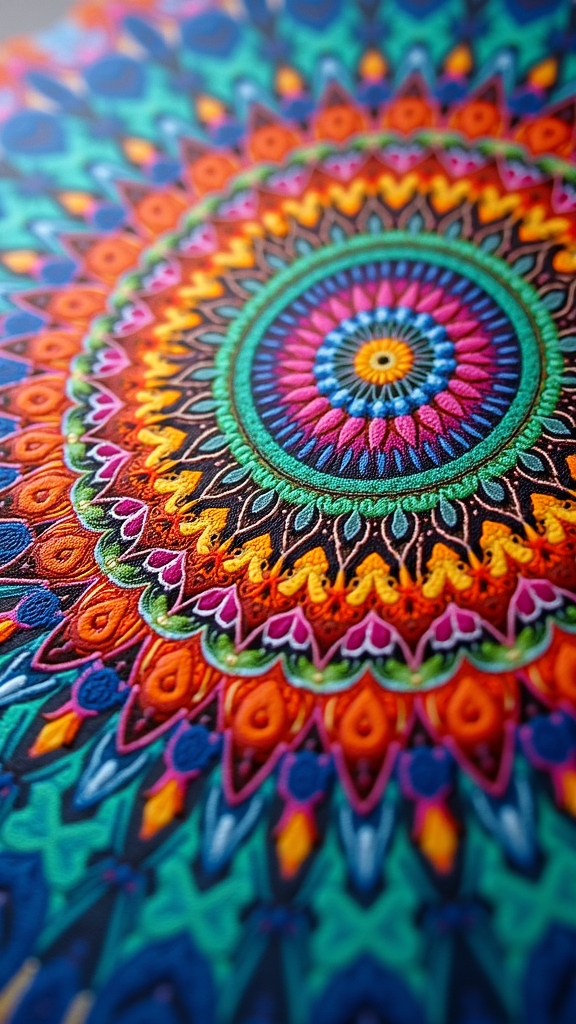
A burst of color can turn an ordinary mandala into something that practically jumps off the page. Choosing bold color palettes isn’t just about making things look cool—it’s about creating art that grabs attention and refuses to let go.
Artists often experiment with contrasting colors, like neon pink on midnight blue, to add serious drama and depth. According to color psychology, different shades can spark all kinds of feelings; warm reds and oranges might energize, while deep blues can calm things down.
Adding metallic or gel pen details on black paper creates a wow factor, making every line pop. Even layering similar shades gives the design a dynamic, complex vibe.
When artists play with bold colors, their mandalas become unique, eye-catching masterpieces—no two ever alike!
Mandala Patterns With Layered Shapes
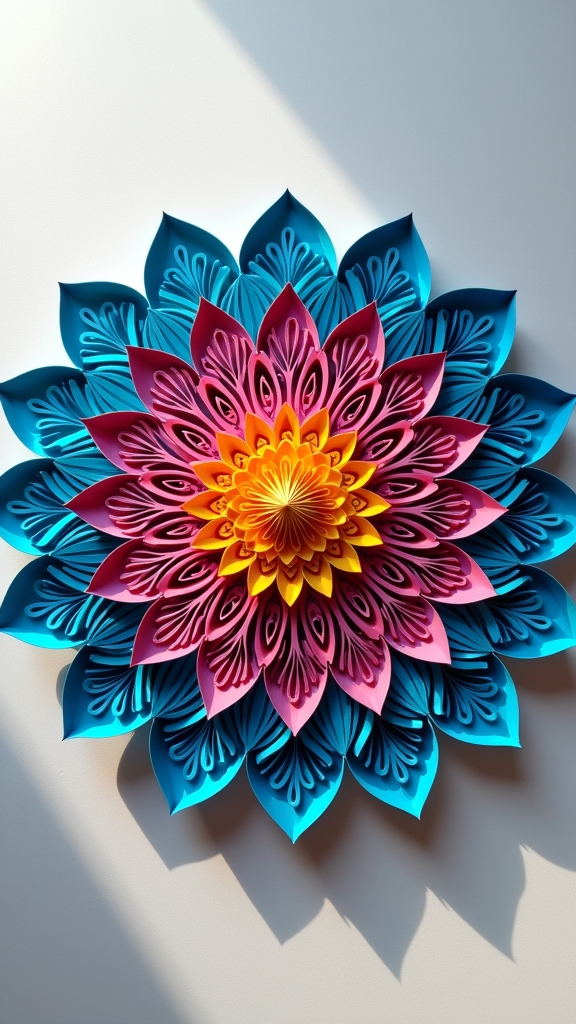
Color isn’t the only trick up an artist’s sleeve—layered shapes in mandala patterns bring a whole new level of wow.
Imagine a mandala where petals, circles, and waves stack up, each layer building on the last. This Layered Symmetry makes the eye travel from the outside right into the center, almost like falling into a mesmerizing tunnel.
It’s not just about looks—layered shapes create depth, complexity, and tons of visual interest!
Here’s what layered mandala patterns can do:
- Layered Symmetry blends different shapes and sizes, boosting harmony and balance.
- Repetition of forms in layers adds rhythm and a sense of flow.
- Natural shapes—like petals and waves—give mandalas an organic vibe, making them feel alive.
Layered shapes? Total game-changer!
Whimsical Mandalas With Playful Elements
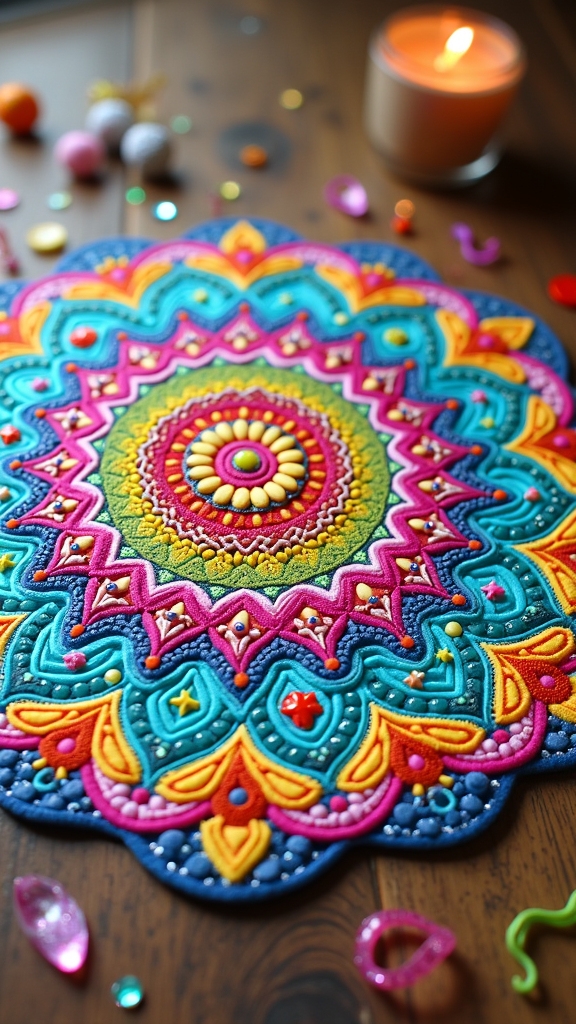
Ever wondered what happens when mandalas decide to throw a party instead of just sitting pretty? That’s when whimsical mandalas burst onto the scene, packed with playful energy and even more playful critters!
Picture cartoonish animals wearing oversized hats, fantastical creatures doing silly dances, and swirls and curves that seem to giggle right off the page. These mandalas aren’t afraid to bend the rules—mixing traditional symmetry with wild, free-flowing shapes that make each design unique.
Bold, vibrant colors turn up the volume, making sure every detail pops and grabs attention. Artists love this style because it lets them embrace their imagination and imperfections, creating something fun and totally personal.
With whimsical mandalas, the only limit is how playful you want to be!
Symmetrical Mandalas With Asymmetrical Twists
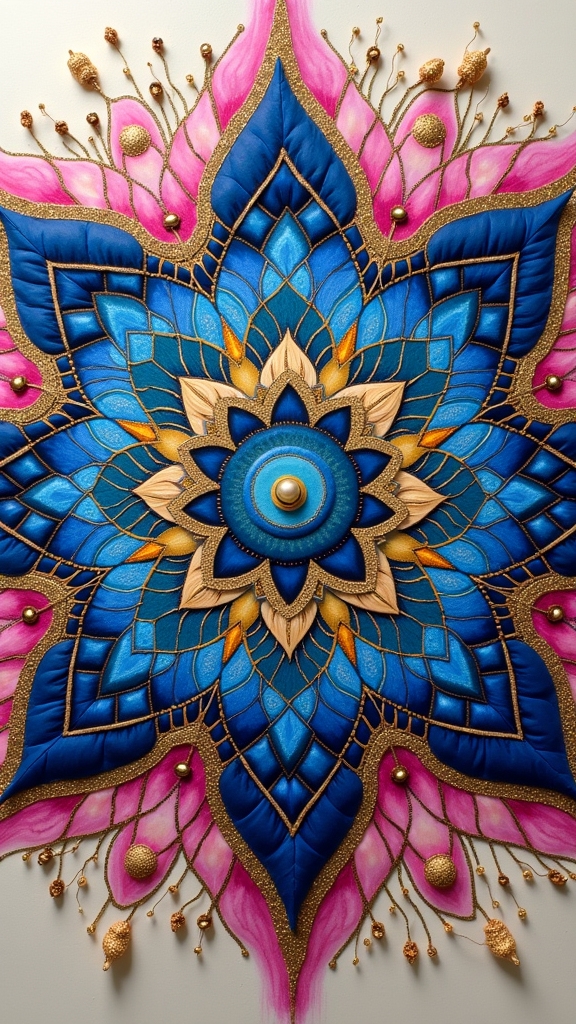
Who says mandalas have to stick to the rules all the time? Sure, symmetrical mandalas are known for their perfect balance, but tossing in a few asymmetrical twists can make them pop with personality.
Artists use Asymmetrical Balance to create surprises that keep your eyes moving—maybe a bold shape here, a wild line there. These unexpected touches don’t wreck the harmony; instead, they make the design way more interesting.
Want to know how artists pull it off? Check out these tricks:
- Add unique shapes or patterns to one section for instant drama.
- Play with color contrasts or thicker lines to highlight certain areas.
- Express personal style by bending the rules—just enough to make it yours.
Asymmetrical Balance? Yes, please!
Mandalas Incorporating Typography
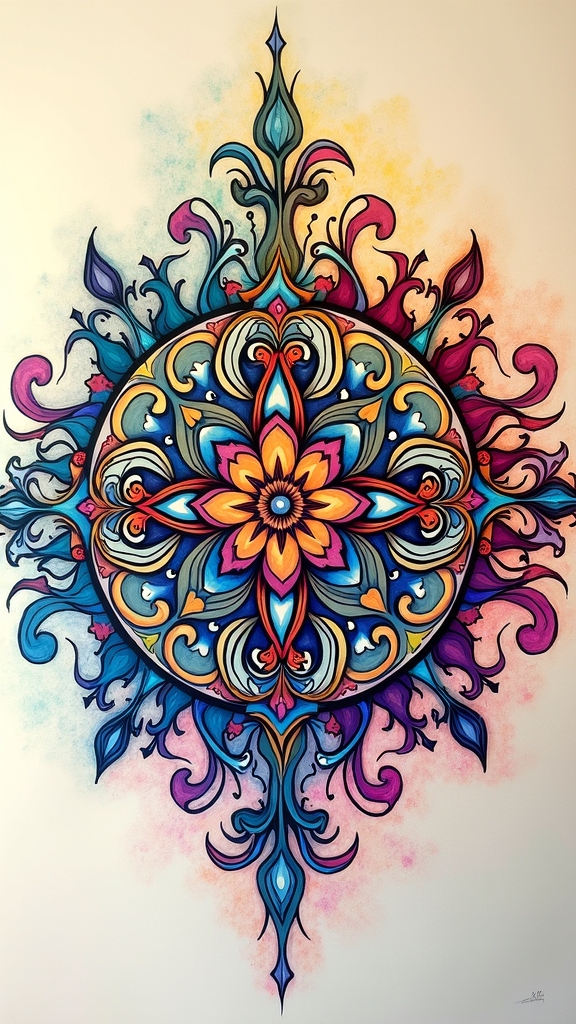
Typography brings a whole new vibe to mandala designs, mixing words with swirls, loops, and patterns for art that actually speaks—literally! When artists blend snazzy fonts and clever lettering with mandala patterns, the result is a wild mashup where Typographic Harmony takes center stage. Maybe a favorite quote spirals around the edge, or a single powerful word pops from the center, guiding your eyes through all the details. Some artists curve words like rollercoasters, others sneak letters into the design’s lines, so you have to look twice. The whole thing feels personal, like the mandala is whispering a secret. Here’s a quick table showing how words and patterns join forces:
| Element | Impact on Mandala |
|---|---|
| Bold Fonts | Strong focal points |
| Script Lettering | Elegant flow |
| Curved Placement | Dynamic movement |
| Integrated Words | Hidden messages |
| Inspiring Quotes | Emotional connection |
Mandalas With Botanical Details
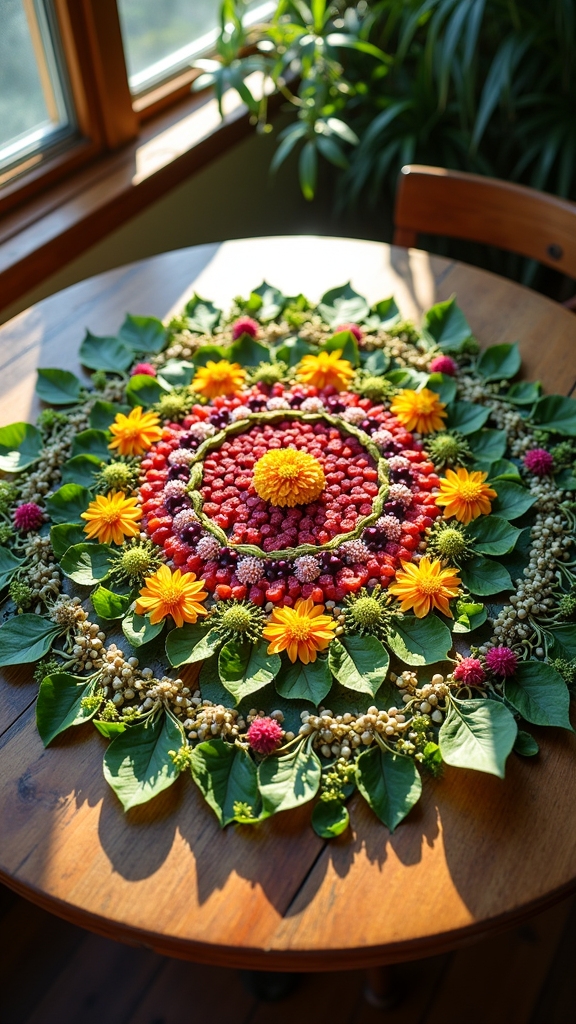
After all that talk about words swirling through mandalas, it’s time to give nature the spotlight. Mandalas with botanical details pull in Botanical Inspirations like leaves, flowers, and vines, twisting their way into perfectly balanced patterns.
These designs aren’t just pretty—they’re super calming, too, thanks to their soft, natural shapes and earthy vibes. Artists love to experiment with greens and bursts of floral color, making each mandala pop with life.
Let’s break down why Botanical Inspirations in mandalas are so magical:
- They help people relax—drawing leafy patterns is oddly soothing.
- Each petal and vine adds a personal touch, making every mandala unique.
- They remind us how awesome nature is, right down to the tiniest stem or swirl.
Who knew plants could look this cool in art?
Mandala Doodles With Free-Form Designs

Sometimes, mandala art just wants to break the rules—and that’s where free-form mandala doodles come in. These designs throw out the strict symmetry and invite artists into a world of creative flow, where spontaneous shapes and playful lines take charge.
Imagine swirling waves, funky flowers, or even a sneaky doodle of a smiling octopus, all weaving into the classic mandala frame. Artists can mix thick and thin lines, add cool shading, or surprise themselves with abstract forms that pop out of nowhere.
The best part? Free-form mandala doodling is super relaxing. As hands move and ideas flow, stress melts away, and focus sharpens. It’s almost like your pencil goes on its own adventure—who knows where it’ll lead next?
Interactive Mandalas for Community Art
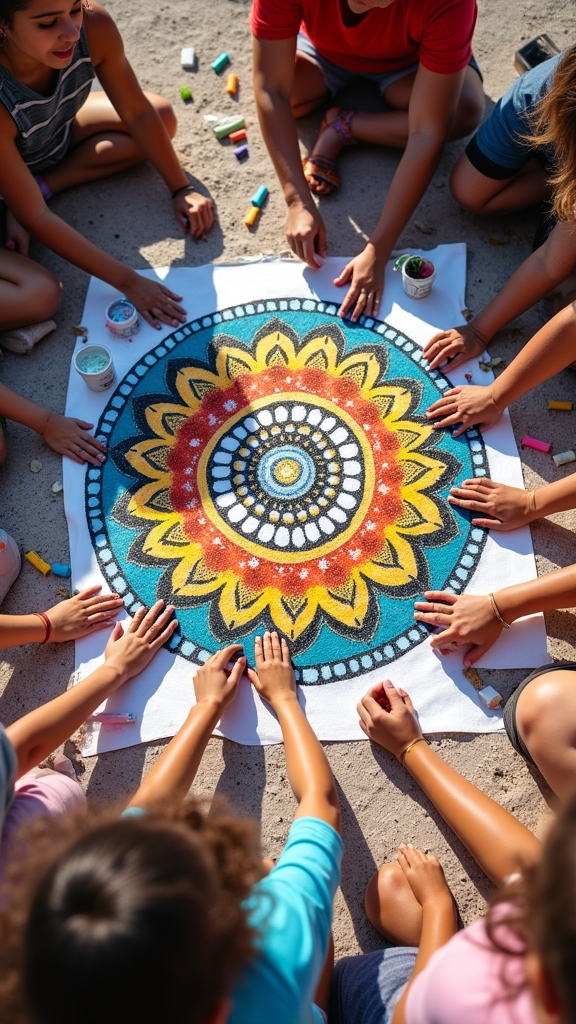
Interactive mandalas turn art into a team adventure, where everyone gets to add their own ideas and patterns to a giant masterpiece, whether it’s in a school hallway or out on a city sidewalk.
These group projects aren’t just about cool designs—they’re a chance for people to share stories, laugh at each other’s wild color choices, and see how different backgrounds can fit together in one big pattern.
It’s art with a side of teamwork and a sprinkle of “Hey, look what we made together!”
Collaborative Group Mandala Projects
Even though art can sometimes feel like a solo adventure, collaborative group mandala projects flip that idea on its head and turn creativity into a team sport.
Everyone gets to be part of the action, building something bigger than any one person could make alone. With group mandalas, people engage—using paint, chalk, or even digital tools—and express themselves, while also working toward the magic of Community Unity.
These projects might focus on local culture or important environmental topics, making every swirl and shape meaningful.
Here’s what makes them special:
- Everyone’s voice shines, no matter their experience.
- Shared themes give the artwork deep, local meaning.
- The final mandala becomes a visual trophy for the whole community to enjoy and celebrate.
Public Space Mandala Installations
When a whole group comes together to create a mandala, the results can be pretty awesome—but imagine that creativity bursting out into the open, right in the middle of a park or city square. Public space mandala installations turn plain spots into lively, interactive art zones. These giant designs invite everyone to pitch in, from little kids to grandparents, making Community Engagement more than just a buzzword. People often use eco-friendly materials—think colorful stones, leaves, or chalk—so the earth gets some love too. Plus, these mandalas aren’t just cool to look at; they’re perfect for events and workshops that get neighbors talking and laughing. Even just making or walking around one can chill you out!
| Location | Materials Used | Event Type |
|---|---|---|
| City Park | Chalk, leaves | Art Workshop |
| School Yard | Painted rocks | Community Picnic |
| Town Square | Recycled plastics | Festival Gathering |
| Garden Space | Flower petals | Meditation Circle |
Community Storytelling Through Patterns
Although a mandala might look like just a bunch of cool patterns at first, these designs can actually tell some pretty amazing stories—especially when a whole community gets involved.
Interactive mandalas are more than just art; they’re like giant storytelling patterns where everyone gets a say. People from all backgrounds can add their own designs or symbols, sharing a piece of their life while working together. The result? A colorful, super-connected tapestry that’s totally unique to the group.
Community mandalas often show up as public installations, making neighborhoods feel cozier and more creative. Plus, building these designs together can actually help people relax and feel less stressed.
Here’s what makes these projects so powerful:
- Collaboration sparks connections.
- Personal stories create rich patterns.
- Art brings people together.
Frequently Asked Questions
What Is the Rule for Creating Mandalas?
The rule for creating mandalas centers on forming symmetrical patterns by dividing a base circle into equal sections. Artists start at the center, radiate outward, and repeat geometric shapes, consistently maintaining balance and symmetry throughout the design process.
What Are the 3 Common Types of Mandala?
When considering Mandala Variations, three common types emerge: Buddhist mandalas, symbolizing cosmic order; Hindu mandalas or yantras, facilitating meditation; and Western mandalas, emphasizing personal expression and creativity. Each type holds unique cultural, spiritual, and artistic significance.
What Is the Psychology Behind Mandala Art?
The psychology behind mandala art centers on its use in creative therapy, as repetitive, symmetrical patterns foster relaxation, enhance focus, and facilitate emotional expression, promoting mindfulness, self-awareness, and healing through structured yet creative visual exploration.
Is Mandala Art Good for the Brain?
Mandala art offers notable mindfulness benefits for the brain, including enhanced relaxation, improved focus, and heightened creativity. Research indicates that its repetitive patterns support emotional regulation, stress reduction, and cognitive performance, making it beneficial for overall mental well-being.
Conclusion
So there you have it—22 mandala ideas that could turn any blank page into a masterpiece. Whether you love wild animal shapes or sparkling metallics, there’s a mandala style for everyone. Maybe you’ll draw a flower, invent a galaxy, or just doodle with no rules at all. Whatever you create, remember: mandalas aren’t just about patterns, they’re about letting your imagination run wild. Grab your pens, get messy, and watch your creativity spin into something amazing!

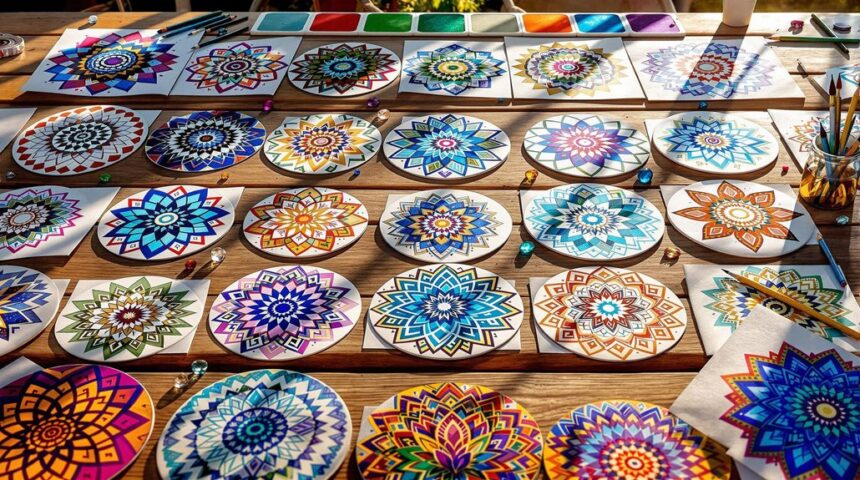
Leave a Reply